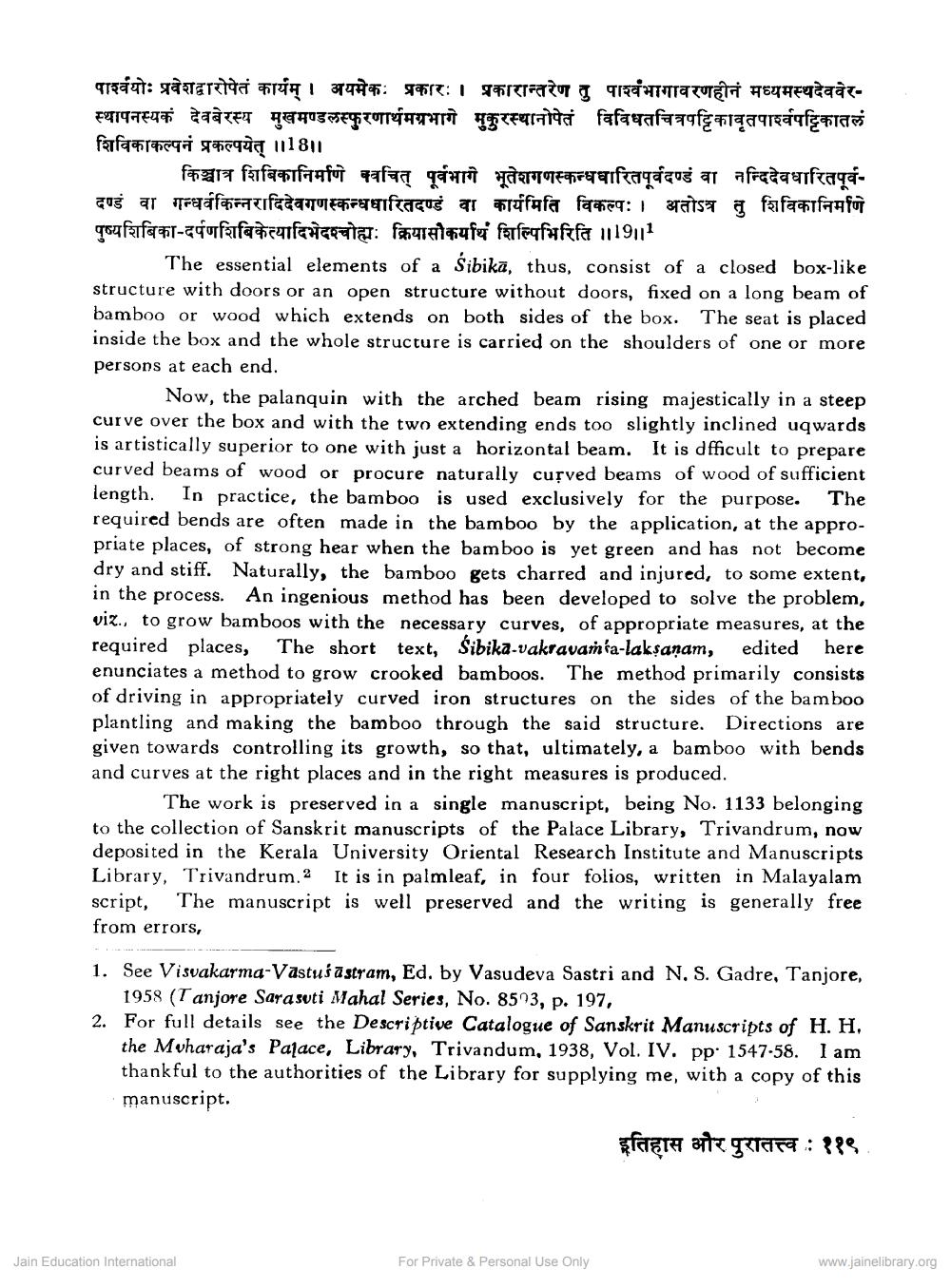Book Title: Method of Grow Crooked Bamboos for Palanquin Beams Author(s): K V Sarma Publisher: Z_Agarchand_Nahta_Abhinandan_Granth_Part_2_012043.pdf View full book textPage 2
________________ arrant: gà Tarte Frigl 3 *: #: I arradur G 91773 rateTi #heydarस्थापनस्यकं देवबेरस्य मुखमण्डलस्फुरणार्थमग्रभागे मुकुरस्थानोपेतं विविधतचित्रपट्टिकावृतपार्श्वपट्टिकातलं fayfa 1690 eua 111811 किश्चात्र शिबिकानिर्माणे क्वचित् पूर्वभागे भूतेशगणस्कन्धधारितपूर्वदण्डं वा नन्दिदेवधारितपूर्वदण्डं वा गन्धर्वकिन्नरादिदेवगणस्कन्धधारितदण्डं वा कार्यमिति विकल्पः । अतोऽत्र तु शिविकानिर्माण पुष्यशिबिका-दर्पणशिबिकेत्यादिभेदश्चोह्मः क्रियासौकर्याथं शिल्पिभिरिति ।।19111 The essential elements of a Sibika, thus, consist of a closed box-like structure with doors or an open structure without doors, fixed on a long beam of bamboo or wood which extends on both sides of the box. The seat is placed inside the box and the whole structure is carried on the shoulders of one or more persons at each end. Now, the palanquin with the arched beam rising majestically in a steep curve over the box and with the two extending ends too slightly inclined uqwards is artistically superior to one with just a horizontal beam. It is dfficult to prepare curved beams of wood or procure naturally curved beams of wood of sufficient length. In practice, the bamboo is used exclusively for the purpose. The required bends are often made in the bamboo by the application, at the appropriate places, of strong hear when the bamboo is yet green and has not become dry and stiff. Naturally, the bamboo gets charred and injured, to some extent, in the process. An ingenious method has been developed to solve the problem, viz.. to grow bamboos with the necessary curves, of appropriate measures, at the required places, The short text, Sibika-vakravanca-laksanam, edited here enunciates a method to grow crooked bamboos. The method primarily consists of driving in appropriately curved iron structures on the sides of the bamboo plantling and making the bamboo through the said structure. Directions are given towards controlling its growth, so that, ultimately, a bamboo with bends and curves at the right places and in the right measures is produced. The work is preserved in a single manuscript, being No. 1133 belonging to the collection of Sanskrit manuscripts of the Palace Library, Trivandrum, now deposited in the Kerala University Oriental Research Institute and Manuscripts Library, Trivandrum.2 It is in palmleaf, in four folios, written in Malayalam script. The manuscript is well preserved and the writing is generally free from errors, 1. See Visvakarma-Vastusastram, Ed. by Vasudeva Sastri and N. S. Gadre, Tanjore, 1958 (T anjore Sara suti Mahal Series, No. 8503, p. 197, 2. For full details see the Descriptive Catalogue of Sanskrit Manuscripts of H. H, the Mvharaja's Palace, Library, Trivandum, 1938, Vol. IV. pp. 1547-58. I am thankful to the authorities of the Library for supplying me, with a copy of this manuscript. इतिहास और पुरातत्त्व : ११९ Jain Education International For Private & Personal Use Only www.jainelibrary.orgPage Navigation
1 2 3 4 5
